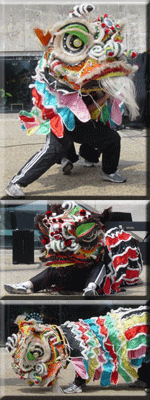The dance sequence usually starts with the lion or lions cautiously coming out of a cave. He sniffs around for danger. Other elements of the dance include: giving respects by bowing, fighting if more than one lion is performing, sleeping, grooming, and drinking. Generally, each dance contains a sequence where the lion or lions eat lettuce or other greens, call the choi cheng. In the United States, the green has come to mean prosperity because it is the color of money. However, the true meaning is that dealing out lettuce is fa tsai in Chinese, which sounds like become prosperous in Chinese. Often a red envelope, called hong bao, is attached as payment. After eating the lettuce, the lion crouches for a moment and then sprays the audience with it. Sometimes the green is placed behind obstacles that the lion needs to pass to get it. Other exotic object have been eaten with different meanings. Sometimes scrolls with lucky sayings are used when spraying lettuce is inappropriate.
Other variations include a dancing Buddist monk, called the Little Buddha, that provokes the lion, plays with it and feeds it. Sometimes the lion will bite the monk. Many dances will add in tricks such as lifts and rolls. These are difficult to coordinate between both dancers and other lions.

